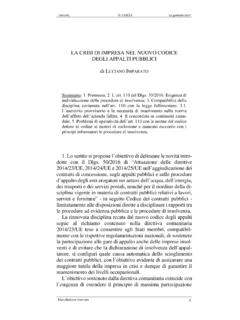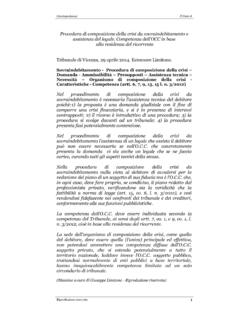Transcription of The Vibratory Stress Relief Library
1 PH: FX: The LibrarVibratory Stress Reliefy REPRINT: Stress Relief OF WELDS BY HEAT TREATMENT AND VIBRATION: A COMPARISON BETWEEN THE TWO METHODS Giovanni S. Crisi Danila Pedrogan Mendonca Author's Submission 2006 Stress Relief OF WELDS BY HEAT TREATMENT AND VIBRATION: A COMPARISON BETWEEN THE TWO METHODS. Giovanni S. Crisi (1) Danila Pedrogan Mendon a (2) ABSTRACT Although not yet accepted officially by the American pressure vessels and piping design and construction codes, which continue to require that Stress Relief of welds be done by heating, the Stress Relief by vibration has gained considerable popularity over the last several years. The scope of this article is to make a description of the vibration method, the theoretical principles upon which it is based, its operational procedures and the present state of the art . The article is complemented by an experimental section.
2 Three pieces of pipe were welded, one of which was left as welded , the second was Stress relieved by heating and the third one was Stress relieved by vibration. Several coupons were cut off the pipes, to be submitted to tensile, impact, hardness tests and metallurgical analysis. Finally, the results of the tests are presented, a comparison is made among them and the authors conclusion is discussed. Key words: residual Stress , Stress Relief , heat treatment, vibration method _____ 1) Chemical Engineer. Professor at the Mackenzie School of Engineering, Sao Paulo, Brazil (2) Materials Engineer. Curitiba, Brazil 11. INTRODUCTION The existing methods for relieving residual Stress from welds are: mechanical, heat and electromagnetic. The mechanical method may be performed by hammering or vibration. The heat method consist of heating the whole welded piece or each weld, one by one.
3 The electromagnetic method uses the electromagnetic hammer technique. In the heat treatment the part is heated until the yield point is reduced to less than the residual Stress , which in turn causes local plastic distortion, decrease of the residual Stress intensity and reduction of hardness. The vibration method introduces energy into the part by means of vibrations. For the stressed atomic structure there is no difference between the energy introduced through heat and the energy introduced through vibrations. The applied energy reorganizes the crystalline structure, relieving Stress and stabilizing the piece, without distortion. This process is especially useful for Stress relieving of big structures, for which the cost of treatment by electrical means would be high, and for parts with severe dimensional tolerances, in which heat treatment could cause distortions that would exceed them.
4 The vibrators generally used have a frequency band of 0 to 100 Hz. They are connected to the structure, which should be supported on rubber blocks. Frequency is gradually increased until the first resonance is reached. This resonance is maintained for a specific period of time and then the frequency is increased again until the second resonance is reached and so on. 2. SOURCES OF RESIDUAL Stress Residual Stress in welds is produced by localized metal tensions occurring immediately after welding, which are: a) Contraction Stress . This is the main source of residual Stress . It takes place during the cooling of the welded areas, which have undergone non uniform heating. b) Stress due to higher surface cooling. When a weld cools down the surface cools faster than the inside, even if this cooling occurs in still air. The greater the thickness, the more Stress is generated. c) Stress due to phase transformation.
5 It occurs due to the transformation of austenite (face centered cube, fcc) to ferrite (body centered cube, bcc), that causes an increase in volume to which the base metal is opposed. The three types of residual Stress usually take place at the same time. Experience proves that the individual effects of each one can be linearly 3. EFFECTS OF RESIDUAL Stress ON WELDS Among others, the effects of residual Stress on welded parts are the following: a) Residual Stress is added to the load the weld has been designed to support, which can lead to the collapse of the material. b) Reduction of Stress corrosion resistance. The regions submitted to elastic tensile Stress may suffer localized corrosion in aggressive environments. c) Risk of cracks. All cracking mechanisms are affected by residual Stress and distortion caused by localized heating.. 1 Silveira.
6 Jos Paulo et. al: Tensoes residuais e deforma oes em soldagem, page 24. Stress Relief BY HEAT TREATMENT Depending on the shape and size of the piece, heat treatment for residual Stress Relief can be carried out by heating the entire piece, or parts of it, in a furnace; or transforming it in a combustion chamber by installing a temporary burner into it, or treating the welds one by one by means of electric resistances. Heating by exothermic kits, which enjoyed some popularity in the sixties and seventies, was abandoned because it did not produce the expected results. 5. Stress Relief BY VIBRATION (VSR) Based on the weight of the piece, the VSR method introduces into it high amplitude and low frequency vibrations for a given period of time. This relieves residual Stress without distortion or alteration of tensile strength, yield point or resistance to fatigue, and the static equilibrium is restored.
7 The most efficient vibrations are the resonant ones, because in the resonance frequency vibrations Stress is better distributed, if compared with sub-resonant frequency. Low frequency vibrations carry high amplitude energy and are very efficient in the significant decrease of peak residual Stress in metallic parts and welds. The equipment usually employed consists of a sturdy vibrator of variable speed which is attached to the piece and an electronic control panel. Both are mounted into a portable cabinet. Also attached to the piece is an accelerometer that detects vibrations and transmits a signal to the control panel. The resonance point is then determined and displayed on a dial. If the vibrator is equipped with a recorder, a chart can also be obtained. The point of resonance is attained by varying the frequency of the vibrator until the proper one is reached. Two minutes is the average time required to reach the resonance frequency.
8 At this point, vibration is maintained for a given time, depending on the weight of the piece and its intended application. The time may range from ten minutes to an hour or more, but if it is exceeded, the piece will not suffer any damage due to fatigue or loss of tensile strength. If structures are very big, long or have open spaces, it may be necessary to apply the procedure in several points. Some equipment carries out the vibration process automatically. Vibration is maintained for 15 minutes, in a sequence of three different selected frequencies, each lasting five minutes. This setting is efficient to treat pieces weighing up to ten tons. For pieces weighing more than ten tons two consecutive 15 minute periods can be used, without the piece suffering any harm. Two simple rules should be followed for all applications: a) Support the piece in the best possible manner, isolating it from the floor or rigid structures, thus leaving it free to vibrate.
9 B) The vibrator should be directly connected to the piece, in order to transfer the entire Vibratory energy generated. The method can be used on a wide range of ferrous and nonferrous metals, including carbon and stainless steel, cast iron, aluminum, titanium etc., in a large variety of shapes. Sizes can vary from small welded parts, shafts and gears, to large welded and machined steel structures. However, it presents some limitations: it is not efficient for extruded, cold worked and precipitation hardened materials. One of the most important benefits of the use of the VSR method is its capacity to relieve Stress at any point of the manufacturing process, such as after machining, snagging, drilling or grinding. In welded parts, Stress Relief can be performed during welding, which is very useful to prevent concentration of residual Stress that may cause warping of the piece. The method is especially compatible with SMAW, GMAW and GTAW welding processes, popularly known as stick electrode, MIG and TIG.
10 With other welding processes some logistical problems may arise. 36. MEASURING THE EXTENT OF Stress Relief Until recently there was no reliable method for the precise measurement of residual Stress , that not only originated from welding, but also from forging, cold drawing and other types of metal working. Now, with the use of diffractometry with x-rays, the problem has been solved. In the past, the only way of checking if residual Stress had been reduced to an acceptable level was by analogy with hardness. It is a well known fact that materials get harder when submitted to Stress . Experience acquired over the years, upon which the applicable standards are still based, demonstrated that if the hardness measured after Stress Relief had been performed was lower than a given empiric value, the treatment had been successful. This condition was especially important if the weld was to be in contact with corrosive environments, as is the case of the chemical industry.








